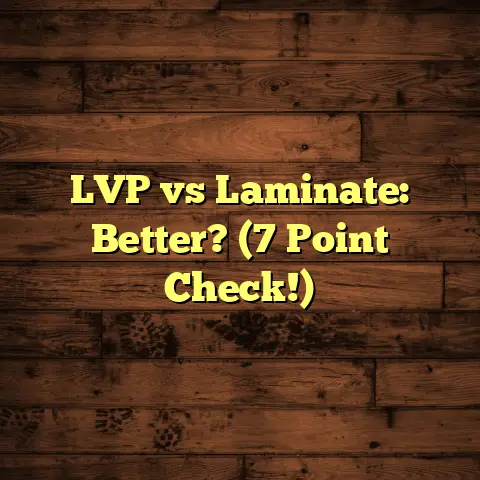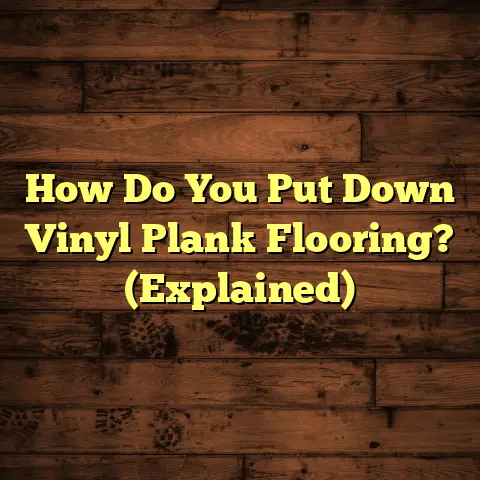Understanding The Pros And Cons Of Different Flooring Types?
Navigating the Pros and Cons of Various Flooring Types
I’m excited to dive into a topic that’s literally under our feet: flooring!It’s something we often take for granted, but the right flooring can transform a space, adding style, comfort, and value to your property.
Ever wonder how much your flooring choices really impact your daily life?
Think about it: * How do you choose the right flooring for your lifestyle? * What are the hidden advantages and disadvantages of the flooring underfoot?
Let’s explore the world of flooring together, uncovering the pros and cons of different types, so you can make the best choice for your needs.
Section 1: Overview of Flooring Types
There’s a whole universe of flooring options out there! From classic hardwood to modern vinyl, each type has its own unique characteristics.
Here’s a quick rundown of some of the most common:
- Hardwood: Timeless elegance and durability.
- Laminate: Affordable and versatile.
- Vinyl: Water-resistant and comfortable.
- Tile: Durable and design-friendly.
- Carpet: Warm and cozy.
- Natural Stone: Luxurious and unique.
We’ll get into the nitty-gritty details of each one in the sections below.
Section 2: Hardwood Flooring
Ah, hardwood! It’s the king of flooring, in my opinion. It’s been a popular choice for centuries, and for good reason.
Think of that rich, warm glow, the satisfying sound underfoot…
But let’s get real – is it the right choice for everyone?
Characteristics:
Hardwood comes in various types of wood, like oak, maple, cherry, and walnut.
Each species has its own unique grain pattern and color. You can also choose from different finishes, such as: * Satin * Semi-gloss * High-gloss
Installation methods vary, but typically involve nailing or gluing the planks to a subfloor.
Pros:
- Durability: With proper care, hardwood can last for decades, even centuries! I’ve seen original hardwood floors in historic homes that are still stunning.
- Timeless Aesthetic: Hardwood never goes out of style. It adds a touch of elegance and sophistication to any room.
- Increased Home Value: Many buyers are willing to pay a premium for homes with hardwood floors. It’s seen as a valuable investment.
- Ease of Maintenance: Regular sweeping and occasional mopping are usually all it takes to keep hardwood looking its best.
Cons:
- Cost: Hardwood is one of the more expensive flooring options, both in terms of materials and installation.
- Susceptibility to Scratches and Moisture: Hardwood can be scratched by pets or furniture, and it’s not ideal for bathrooms or kitchens where moisture is a concern.
- Required Upkeep: While maintenance is generally easy, hardwood may require refinishing every few years to maintain its luster.
I remember one client who insisted on hardwood in their bathroom. Despite my warnings, they went ahead with it.
A year later, I got a call about water damage. Sometimes, even the most beautiful flooring isn’t the right fit for every space!
Section 3: Laminate Flooring
Now, let’s talk about laminate. It’s often seen as the budget-friendly alternative to hardwood, but it has its own advantages.
Definition and Construction:
Laminate flooring is a multi-layer synthetic flooring product fused together with a lamination process.
It typically consists of:
- A wear layer: A transparent top layer that protects against scratches and stains.
- A decorative layer: A high-resolution image that mimics the look of wood, stone, or tile.
- A core layer: Usually made of high-density fiberboard (HDF) or medium-density fiberboard (MDF), which provides stability and impact resistance.
- A backing layer: Provides moisture resistance and helps prevent warping.
Pros:
- Affordability: Laminate is significantly less expensive than hardwood, making it a great option for budget-conscious homeowners.
- Wide Range of Styles: Laminate comes in a huge variety of colors, patterns, and textures, so you can find something to match any décor.
- Resistance to Scratches and Stains: The wear layer on laminate is designed to withstand everyday wear and tear, making it a good choice for homes with pets or children.
- Easy Installation: Many laminate floors feature a click-lock system that makes installation a breeze. DIYers can often install laminate themselves, saving on labor costs.
Cons:
- Less Durability Compared to Hardwood: While laminate is durable, it’s not as long-lasting as hardwood. It may need to be replaced sooner, especially in high-traffic areas.
- Potential for Water Damage: Laminate is more water-resistant than hardwood, but it’s not waterproof. If water seeps into the seams, it can cause swelling and damage.
- Less Authentic Feel: While laminate can mimic the look of wood, it doesn’t have the same warmth and character as real hardwood.
I once helped a client install laminate flooring throughout their entire house. They were thrilled with the cost savings and how easy it was to install.
However, a few years later, they had a plumbing leak that ruined a large section of the flooring.
The lesson? Even with water-resistant flooring, it’s important to take precautions and address any leaks promptly!
Section 4: Vinyl Flooring
Vinyl flooring has come a long way since the linoleum of our grandparents’ era!
Today’s vinyl options are stylish, durable, and incredibly versatile.
Evolution of Vinyl Flooring:
Vinyl flooring has evolved significantly over the years. Modern options include:
- Luxury Vinyl Planks (LVP): Designed to mimic the look of hardwood, LVP comes in planks that click together for easy installation.
- Luxury Vinyl Tile (LVT): Designed to mimic the look of stone or tile, LVT comes in tiles that can be installed with grout for a more authentic look.
- Sheet Vinyl: Comes in large rolls that can be cut to fit any room. It’s a good option for bathrooms and kitchens because it has fewer seams than planks or tiles.
Pros:
- Water Resistance: Vinyl is completely waterproof, making it an excellent choice for bathrooms, kitchens, and basements.
- Comfort Underfoot: Vinyl has a softer, more cushioned feel than hardwood or tile, making it more comfortable to stand on for long periods.
- Variety of Styles: Vinyl comes in a wide range of colors, patterns, and textures, so you can find something to match any décor.
- Straightforward Installation: Many vinyl floors are easy to install, especially LVP and LVT with click-lock systems.
Cons:
- Potential for Fading: Vinyl can fade over time, especially in areas that are exposed to direct sunlight.
- Not as Eco-Friendly as Other Options: Vinyl is made from synthetic materials, which are not as environmentally friendly as natural options like hardwood or bamboo.
- Possible Off-Gassing of VOCs: Some vinyl floors can release volatile organic compounds (VOCs), which can affect indoor air quality. Look for low-VOC options to minimize this risk.
I recently installed LVP in my own basement. I was amazed at how easy it was to install and how great it looked.
Plus, I have peace of mind knowing that it’s completely waterproof in case of any flooding.
Section 5: Tile Flooring
Tile is another classic flooring option that’s known for its durability and versatility.
From sleek porcelain to rustic ceramic, tile can add a touch of elegance to any space.
Different Types of Tile Flooring:
- Ceramic Tile: Made from clay that’s fired at high temperatures. It’s a good option for bathrooms, kitchens, and entryways.
- Porcelain Tile: A type of ceramic tile that’s denser and more water-resistant than regular ceramic. It’s a good option for high-traffic areas and outdoor spaces.
- Natural Stone Tile: Made from natural materials like marble, granite, and slate. It’s a luxurious option that adds a unique touch to any room.
Pros:
- Durability: Tile is incredibly durable and can last for decades with proper care.
- Water Resistance: Tile is waterproof, making it an excellent choice for bathrooms, kitchens, and other areas that are exposed to moisture.
- Ease of Cleaning: Tile is easy to clean with a damp mop or sponge.
- Vast Array of Design Options: Tile comes in a huge variety of colors, patterns, and sizes, so you can create a unique look that matches your style.
Cons:
- Coldness Underfoot: Tile can be cold to the touch, especially in colder climates. Consider adding radiant heating underneath the tile for added comfort.
- Potential for Cracking: Tile can crack if it’s subjected to heavy impact or if the subfloor is uneven.
- Challenging Installation: Installing tile can be challenging, especially for DIYers. It requires precise cutting and grouting to achieve a professional look.
I once helped a client remodel their kitchen using beautiful porcelain tile.
The transformation was amazing! The tile added a touch of elegance and sophistication to the space.
However, the installation was tricky, and it took several days to complete. But the end result was well worth the effort!
Section 6: Carpet Flooring
Carpet is the go-to choice for adding warmth and comfort to a room. It’s soft, cozy, and comes in a wide range of styles and colors.
Carpet Flooring and Its Various Styles:
- Loop Pile: Features uncut loops of yarn. It’s durable and resistant to matting, making it a good choice for high-traffic areas.
- Cut Pile: Features yarn that’s been cut at the tips. It’s softer and more luxurious than loop pile, but it can be more prone to matting.
- Berber: A type of loop pile carpet that’s known for its durability and stain resistance.
- Shag: Features long, shaggy fibers. It’s soft and plush, but it can be difficult to clean.
Pros:
- Warmth: Carpet provides insulation and warmth, making it a comfortable choice for bedrooms and living rooms.
- Sound Absorption: Carpet absorbs sound, reducing noise levels in your home.
- Comfort: Carpet is soft and comfortable underfoot, making it a great choice for families with children.
- Wide Range of Styles and Colors: Carpet comes in a huge variety of styles, colors, and patterns, so you can find something to match any décor.
Cons:
- Maintenance Challenges (Stains and Allergens): Carpet can be difficult to clean, especially if it’s stained. It can also trap allergens, making it a poor choice for people with allergies.
- Potential for Wear Over Time: Carpet can wear out over time, especially in high-traffic areas.
- Not Ideal for Moisture-Prone Areas: Carpet is not a good choice for bathrooms, kitchens, or basements because it can trap moisture and promote mold growth.
I remember helping a client choose carpet for their children’s playroom.
They wanted something soft, comfortable, and durable. We ended up choosing a low-pile carpet with a stain-resistant treatment.
The kids loved it, and the parents were happy with how easy it was to clean!
Section 7: Natural Stone Flooring
For a touch of luxury and timeless beauty, natural stone flooring is hard to beat.
Each piece is unique, with its own natural variations and character.
What Constitutes Natural Stone Flooring:
- Marble: A luxurious stone that’s known for its beautiful veining.
- Granite: A durable stone that’s resistant to scratches and stains.
- Slate: A rustic stone that’s known for its unique texture and color variations.
- Travertine: A porous stone that’s known for its warm, earthy tones.
Pros:
- Unique Beauty: Natural stone is unique and adds a touch of luxury to any room.
- Durability: Natural stone is incredibly durable and can last for centuries with proper care.
- Increased Home Value: Natural stone flooring can increase the value of your home.
Cons:
- Higher Cost: Natural stone is one of the most expensive flooring options.
- Heavy Maintenance Needs: Natural stone requires regular sealing and polishing to maintain its luster.
- Potential for Scratching and Staining: Some types of natural stone, like marble, are prone to scratching and staining.
I once worked on a project where we installed marble flooring in a grand entryway.
The result was stunning! The marble added a sense of elegance and sophistication to the space.
However, the installation was complex, and the maintenance requirements were significant.
But for the client, the beauty and prestige of natural stone were worth the extra effort.
Section 8: Eco-Friendly Flooring Options
More and more homeowners are looking for sustainable and eco-friendly flooring options.
Luckily, there are some great choices that are both beautiful and good for the planet.
The Rise of Sustainable Flooring Options:
- Bamboo: A fast-growing grass that’s a sustainable alternative to hardwood.
- Cork: A renewable resource that’s harvested from the bark of cork trees.
- Reclaimed Wood: Wood that’s been salvaged from old buildings or structures.
Pros:
- Sustainability: Eco-friendly flooring options are made from renewable or recycled materials.
- Unique Aesthetics: Eco-friendly flooring options often have unique textures and patterns that add character to a room.
- Health Benefits (Low VOCs): Many eco-friendly flooring options are low in VOCs, which can improve indoor air quality.
Cons:
- Availability: Some eco-friendly flooring options can be difficult to find, especially in certain areas.
- Potential for Higher Costs: Some eco-friendly flooring options can be more expensive than traditional options.
- Varying Durability: The durability of eco-friendly flooring options can vary depending on the material and manufacturing process.
I recently helped a client install bamboo flooring in their living room. They were committed to using sustainable materials in their home renovation.
The bamboo flooring looked beautiful, and they were happy knowing that they were making an environmentally responsible choice.
Section 9: Comparing Costs and Lifespans
Let’s get down to brass tacks: how much does each flooring type cost, and how long will it last?
Here’s a general overview, but keep in mind that prices can vary depending on the quality of the materials and the complexity of the installation.
| Flooring Type | Average Cost per Sq. Ft. (Installed) | Average Lifespan |
|---|---|---|
| Hardwood | \$8 – \$25 | 50-100+ years |
| Laminate | \$3 – \$12 | 10-25 years |
| Vinyl | \$3 – \$15 | 10-20 years |
| Tile | \$5 – \$20 | 75-100+ years |
| Carpet | \$3 – \$10 | 5-15 years |
| Natural Stone | \$10 – \$50+ | 100+ years |
| Bamboo | \$6 – \$15 | 20-50 years |
| Cork | \$5 – \$15 | 20-40 years |
Cost Considerations:
- Initial Installation Costs: This includes the cost of materials, labor, and any necessary subfloor preparation.
- Maintenance Costs: This includes the cost of cleaning supplies, repairs, and refinishing (if applicable).
- Potential Replacement Costs: Consider how often you’ll need to replace the flooring and factor that into your long-term budget.
Lifespan Considerations:
- Traffic Levels: High-traffic areas will require more durable flooring options.
- Lifestyle: Homes with pets or children will require flooring that can withstand wear and tear.
- Maintenance: Proper maintenance can extend the lifespan of any flooring type.
Section 10: Personal Preference and Lifestyle Considerations
Ultimately, the best flooring choice depends on your personal preferences and lifestyle.
Lifestyle Factors:
- Pets: If you have pets, you’ll want to choose flooring that’s resistant to scratches and stains. Hardwood, laminate, vinyl, and tile are all good options.
- Children: If you have children, you’ll want to choose flooring that’s soft, comfortable, and easy to clean. Carpet, vinyl, and laminate are all good options.
- Climate: In humid climates, you’ll want to choose flooring that’s resistant to moisture. Vinyl, tile, and some types of laminate are good options.
Personal Preferences:
- Aesthetic Style: Choose flooring that complements your overall décor and personal style.
- Comfort: Consider how the flooring feels underfoot. Do you prefer something soft and cushioned, or something firm and durable?
- Budget: Set a budget and stick to it. There are great flooring options available at every price point.
I always tell my clients to think about how they actually live in their homes.
Do they have kids running around? Do they love to cook and entertain? Do they have pets who shed?
Answering these questions can help narrow down the best flooring choices for their needs.
Conclusion
Choosing the right flooring is a big decision. It impacts the look, feel, and value of your home.
We’ve covered a lot of ground today, exploring the pros and cons of various flooring types.
Remember, there’s no one-size-fits-all answer. The best choice depends on your individual circumstances, budget, and preferences.
Take your time, do your research, and weigh the pros and cons carefully.
And don’t be afraid to ask for help from a professional flooring contractor.
Call to Action
Now, I’d love to hear from you! What are your experiences with different types of flooring?
Do you have any tips or tricks to share? Leave a comment below and let’s start a conversation!





